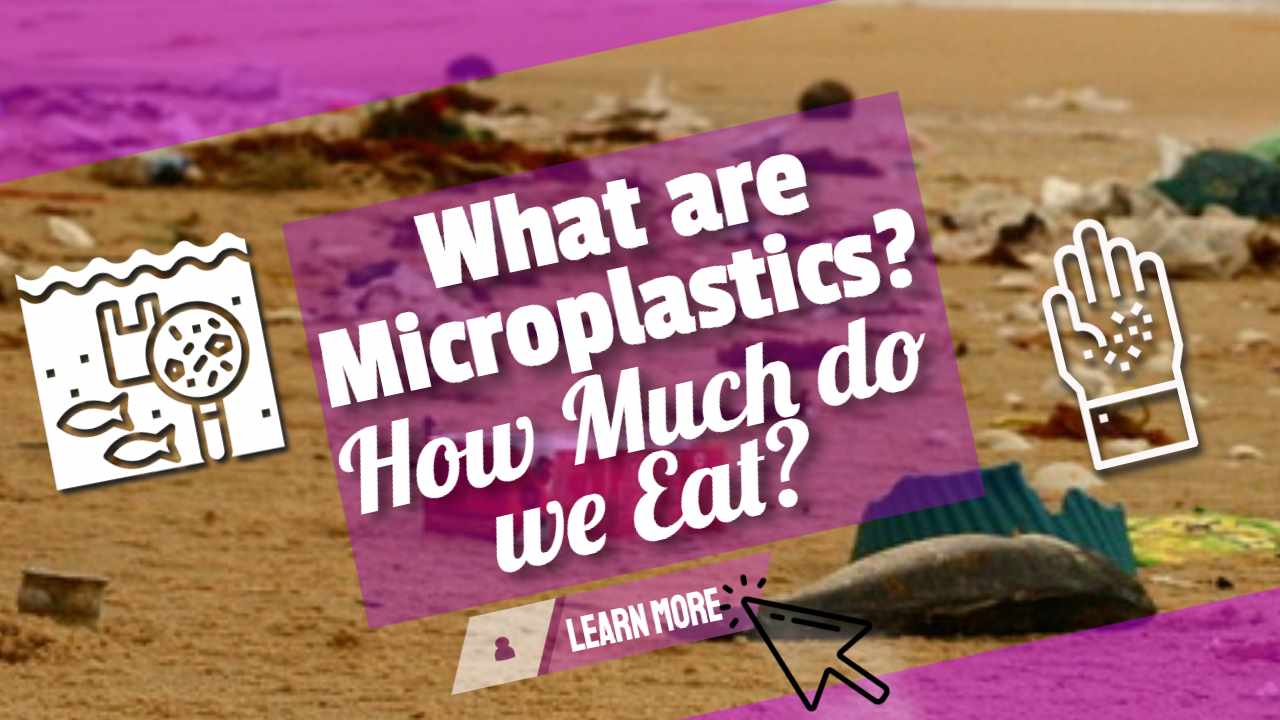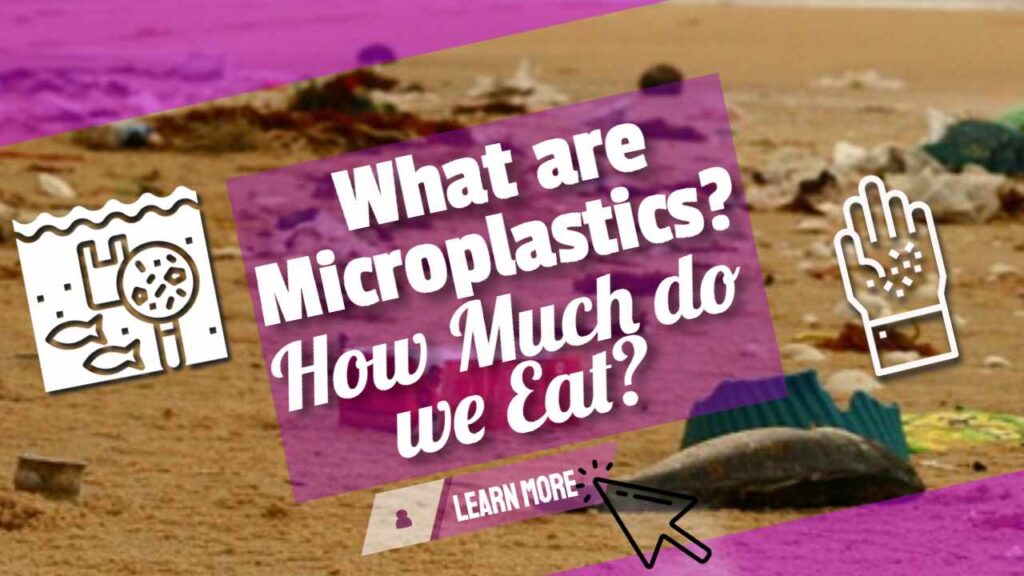We define microplastics, and once that is understood, the next logical question is, “How much microplastic do we consume?” As a result, we'll attempt to address it as well. Additionally, “Is that beneficial to my health?” Surprisingly, nobody seemed to know.
Once microplastics reach the environment, they do not biodegrade. They accumulate in animals, particularly fish and shellfish, and are subsequently consumed by humans as food. Microplastics have been detected in a variety of settings, including freshwater, marine, and terrestrial, as well as in food and tap water. They have been detected in bottled water and even blow in the wind to be inhaled.
Microplastic contamination is a threat that has slipped by the world's experts, who were unaware of its existence until lately. This was most likely owing to the fact that plastic makers have never disclosed the materials they use. They have asserted that their additional information is “commercial property” and confidential. As a result, they do not disclose the ingredients they use to strengthen and colour their plastic. Nor do they ever disclose what low-cost “bulking materials” they use to make their products affordable.
Thus, it is critical that everyone exerts pressure on governments to force plastic makers to disclose the specific chemicals they employ.

How do microplastics affect our health?
Due to the fact that scientific research on the effects of microplastics is still in its infancy, no one understands how they may damage human health. Furthermore, we have no idea how much microplastic we ingest. However, it is safe to infer that ingesting any amount of plastic is never a good idea. It has no place there, and that cannot be disputed. At the present, further study is needed to establish the precise mechanism through which eating microplastics may harm human health.
Microplastics include toxic chemicals and hormone-altering molecules that can impair human health in a variety of ways, from reproduction to immune function,” Crowley noted.
People may wonder why we use plastic in so many products if it is potentially toxic or harmful to human health. Although plastic is not dangerous when used for food packaging, it is utilised in a broad variety of other products without disclosing the plasticizers and additives used.
Without the inclusion of plasticizers, many plastics are brittle, and the industry also integrates cheap “bulkers” into the plastic. Then there are the added colourants.
Additional study is necessary to have a thorough understanding of the consequences of microplastics on human health and the health of our oceans. As can be seen, many plastics are manufactured using components that are not intended for human consumption.
Microplastics impair the ocean's ability to sequester carbon via plankton, so compromising the quality of the air we breathe. While also jeopardising the vital food chain of every ocean.
Numerous microplastics that end up in the sea are consumed by a diverse range of marine organisms, the majority of which being fish, shellfish, and crustaceans. And, as a result of their widespread consumption, these animals end up having an effect on human health as well.
Evidence Suggests Microplastics Damage Living Cells
Ordinary people may wonder why we use so much plastic if it is potentially hazardous to human health. That is a good question, given our ignorance of the amount of microplastic we ingest.
While the health implications of digesting microplastics on living organisms are debatable, we have uncovered a physical mechanism for the mechanical stretching of model cell lipid membranes induced by adsorbed micrometre-sized microplastic particles that are ubiquitous in oceans.
As a result, the membrane's lifetime is significantly decreased. Using the aspiration micropipette approach, the effect of mechanical stretching of microplastics on live cell membranes was demonstrated on red blood cells. Mechanical stretching of lipid bilayers may aid researchers in better understanding the impact of microplastic particles on biological systems.
Definition of Microplastics
Microplastics are defined as little pieces of plastic garbage less than 5mm in length. They are mostly created by the degradation of plastic garbage and have been detected in rivers, lakes, drinking water sources, and bottled water, according to the Guardian.
Microplastics' Health Effects
Significant further research is required to have a better understanding of the potential harm that microplastics may do to the environment and human health.
The first specialists to study the effects of microplastics have identified a substantial new source of microplastic. They made the discovery right in front of us! It is released during the laundry of synthetic clothes and then runs directly through sewage treatment plants and into all rivers and seas.
Additionally, once microplastics are ingested, they cannot be removed from any living organism, human or animal. There is no provider of wild seafood who can guarantee the absence of microplastics in their products.
Additionally, specialists must determine that the health consequences of consuming plastic-contaminated fish are not fully recognised.
Individuals are exposed to microplastics not just via the food they consume, but also through the air they breathe.
According to a 2017 research on human health and microplastics, “human exposure to microplastics via the air has just recently been identified.” Thus, before we can answer the issue of how much microplastic we ingest, we must first identify the sources.
Lifetime Accumulation of Microplastic (MP) in Adults and Children
To do this, a probabilistic lifetime MP exposure model for children and adults is created that fully accounts for the variability of mp over several known intake medium and global consumption rates. The amount of mp deposited in human tissue and the amount consumed in faeces are also determined in terms of particle number and mass distribution.
Few states have passed new health and safety regulations, prompting the state water board's immediate approval of a definition of microplastics in drinking water.
A standardised strategy for microplastics testing in drinking water must be devised and executed, as well as requirements for four years of testing. All governments should immediately enact legislation requiring, at a minimum, the reporting of microplastics in drinking water and the public dissemination of the data.
The amount of microplastics accumulated throughout a lifetime in children and adults can be measured only once experts agree on a method for testing for microplastics. How much microplastic do we ingest is an unanswerable issue unless scientists agree on a credible technique of measurement.
Microplastics aren’t just from drinking water
Plastic contamination of drinking water is far from the only source of worry. All plastic disposed of in landfills will eventually disintegrate into microplastic and end up in the oceans. In September 2018, MEPs adopted a plastics strategy with the objective of raising the recycling rate of plastic trash in the EU. Additionally, they encouraged the European Commission to enact a ban on purposefully added microplastics in cosmetics and detergents by 2020, as well as to take efforts to decrease microplastic discharge from textiles, tyres, paint, and cigarette butts.
Microplastics were studied in the isolated Antarctic Weddell Sea by specialists from the University of Basel. The team collected a total of 113 samples of water from the surface and below. They collected 770 microplastic particles, of which 45.5 percent were from marine paint. This was mostly attributed to their own ship.
Today, the worldwide community has succeeded in significantly reducing major microplastics, particularly those that are superfluous, such as microbeads. On the other hand, microplastics are still used in biomedical research and in air blasting technology for the removal of paint and rust from metal.
What Further Research Is Needed To Assess The Spread And Impact Of Microplastics?
What is being done to combat microplastics is a legitimate concern. We have stated that not enough research has been conducted on microplastics. On August 22, 2019, the World Health Organization suggested a more comprehensive assessment of microplastics in the environment and their potential health impacts.
Additional research is needed on all forms of microplastic contamination and its health impacts. There is still a great deal of work to be done before we can accurately estimate how much microplastic we ingest.
Exposure Linked to Infertility Inflammation and Cancer
Microplastic pieces ranging in size from the width of a hair to visible shards are formed as a result of the abrasion of plastic particles thrown into the environment.
Infertility, inflammation, and cancer have all been linked to exposure to tiny plastics in wildlife and laboratory animals. It may also have a role in obesity. The researchers are presently investigating donated tissues for microplastics that have accumulated over the course of the donors' lives.
Plastic Model Simulations and Validation
Continuous microplastic loading from numerous major sewage (wastewater) outfalls demonstrated an incremental development of microplastic in Puget Sound's centre and southern portions over time. This might endanger the health of oyster beds that stretch over the central and southern sounds.
Chemicals Leaching from Plastic in Gut
Chemicals seeping from plastic in the guts of animals and people are causing anxiety among scientists. This might happen as a result of:
- Desorption of persistent, bioaccumulating, and poisonous (PBT) substances from plastics,
- Leaching of plasticising compounds derived from plastics.
- Physical damage.
The following are the essential questions:
- How much of a direct physical impact do microplastics have, and
- To what degree do they serve as an extra vector for chemical pollutants, increasing or lowering PBT exposure in sensitive organisms?
- Once in the marine environment, microplastics are subjected to a variety of physical and chemical reactions, including:
- Biofouling and leaching, as well as secondary pollutant incorporation.
According to a recent assessment by the United Nations Food and Agriculture Organization, individuals do absorb trace levels of microplastics from aquatic life.
Fortunately, we don’t consume nearly as much as other animals since humans primarily eat animal muscle tissue, leaving out the guts of fish, where the majority of microplastics and toxins gather.
Microplastics: How you can reduce them
Microplastics are posing a growing threat to the environment. It will take several years of investigation to identify the exact danger level of microplastics.
Given what we already know about the health concerns associated with plastics in general, it is likely that further negative effects will emerge as the study develops.
Are you aware, for example, that they are small enough to slip through household water filters and into tap water?
Additionally, microplastics are employed in a variety of scent encapsulation processes. These fragrance oils are encapsulated and added to fabric softeners and detergents to provide long-lasting fragrances with less perfume.
However, what are microplastics precisely, how did they get there, and what can be done to alleviate the harm they cause?
Microplastics have made headlines with the same insidious ubiquity that they have permeated our daily life and natural environment in recent years. Apart from avoiding products that contain them purposely, such as toothpaste, we may all contribute to their reduction by:
- not buying plastic products. Choose alternative goods made from wood and only natural materials
- avoiding plastic packaged products. Choose paper and cardboard wrapped goods only
- buying nothing but natural clothing (cotton, wool etc).
Where do microplastics come from?
Microplastics are frequently imperceptible to the naked eye, and they enter the sewage system immediately from the washing machine, sink, and bathroom drain, as previously indicated.
They pass through wastewater treatment systems unnoticed.
Tyre abrasion contributes up to 68,000 tonnes of microplastic pollution to the environment each year, of which 7,000 to 19,000 end up in UK waterways.
This is, in a nutshell, how the majority of microplastics reach the seas and contribute to the swirling ‘plastic soup.'
Microplastics are absorbed or consumed by sea organisms and are then passed down the marine food chain. As the apex of the food chain, humans consume microplastics as well.
Microplastics are not biodegradable and are nearly impossible to remove from the (marine) environment once they reach there. Using body washes or cosmetics that include microplastic endangers the ocean, ourselves, and our children!
Microplastics are defined as plastic particles with a diameter of less than 5mm but greater than 1 micron (1/1000th of a millimetre), and their impact as one of the most pervasive and persistent pollutants on the planet is just now being properly explored. Microplastics are present in a variety of products, including glitter, microbeads, and fragments of larger pieces of plastic waste, as well as clothing.
How do washing machines contribute to microplastic pollution?
The majority of people are aware that synthetic materials (polymers, microplastics, or plastics) contribute significantly to global environmental deterioration and species extinction. However, did you know that when we wash synthetic items, we contribute to microplastic contamination through our washing machines?
Experimenters revealed that a single garment can generate more than 1900 fibres every wash after collecting wastewater from domestic washing machines.
When we wash our clothes, these little synthetic fibres from our synthetic polymer garments are deposited in washing machine waste drainage systems.
Each year, the UK is predicted to create between 2,300 and 5,900 tonnes of microplastic contamination.
More Ways to Reduce Microplastics
Decrease our reliance on single-use plastics (refill water bottles, buy in bulk, and buy items packaged in other materials like glass or paper). Encourage the development of a standardised approach for microplastics analysis. Due to the lack of a standardised technique for evaluating the amount of microplastic in water or tissue, the results obtained by one laboratory cannot be compared to those obtained by another.
We do not yet know the impact of these microplastics on human health. However, hard flooring, a greater use of natural fibres in clothing, furniture, and homewares, and at least weekly vacuuming can all assist to reduce your exposure.
Worldwide organisations, including those responsible for the aforementioned publications or studies, are encouraging more efforts to remove microplastic marine litter and more scientific research to help us understand microplastics. The plastics sector is a strong supporter of these aims.
Plastic particles can affect our immune system
Microplastics were linked to brain impairment in fish in one study. Their research demonstrates that plastic nanoparticles migrate up the food chain, infiltrate the brain of the top consumer, and exert a major impact on its behaviour, so affecting the functioning of natural ecosystems.
Styrene, another chemical found in plastic and some food packaging, has been linked to a number of health problems, including nervous system problems, hearing loss, and cancer. Microplastic particles, according to Flaws, can also accumulate polychlorinated biphenyls (PCBs), which have been linked to a number of health problems, including cancer, a weakened immune system, and reproductive disorders.
In summary, those microscopic bits of plastic penetrate our systems and circulate throughout our bodies, where they may have a range of negative effects on our health. They have the potential to influence our immune system, digestive system, endocrine system, and other systems.
Media coverage of Microplastics articles: How Much Microplastic do we Consume
The mainstream media has recently reported on reports of minuscule wind-blown plastic particles. This dramatically increases microplastics' mobility and dissemination. Scientists at Utah State University revealed that each year, around 1,000 tonnes of microplastic particles fall on America's National Parks and other wilderness areas.
By highlighting the annual flow of 41 million tonnes of plastic into the oceans, the media helps people understand the magnitude of the problem. While the majority of readers will find this useless, knowing that it is equivalent to 100,000 garbage truckloads will assist them in comprehending. Floating plastic continents in different oceans, turtles that eat plastic bags, and dead whales with plastic garbage stomachs are just a few of the recent discoveries that have garnered significant media attention.
“Almost certainly, when we eat an apple, we are also consuming microplastics,” argues Sion Chen, a Greenpeace media campaigner.
Are litter, plastic and microplastic quantities increasing in the ocean?
Yes. Litter, trash, microplastics, and even nanoplastics are increasing in the water.
Only living materials deteriorate and disappear; the remainder do not rot and slowly degrade over hundreds of years. Regardless of how much microplastic we consume now, it will continue to increase in the future.
Tiny Robots Could Clean Up Microplastic Pollution
Microplastics are extremely small and very hard to clean up. The main cause of ocean pollution, they are extremely small pieces of plastic created by the breakdown of larger plastic waste. The minute pieces are often hard to see with the naked eye. In theory, at some time in the future tiny robots could be programmed to find them and collect them and that might even be financed by the value of the plastic which could then be processed and recycled.
This might occur, but not for a long time. No current technology could do this.
Microplastics as marine pollutant
Since the 1940s, when industrial production of plastics began, microplastic contamination of the marine environment has been a growing issue. The mechanisms by which microplastics enter the marine environment may be quantified with any degree of precision only if protocols for assessing methods for detecting microplastics in the marine environment are agreed upon.
Only then would it be possible to analyse spatial and temporal trends in microplastic abundance and, as a consequence, discuss the environmental impact of microplastics and propose viable solutions.
The Single-Use Plastics Crisis
Plastic pollution cannot be resolved just via research. Plastic use is not the cause of the problem. The fundamental issue, though, is the single-use lifestyle to which we have grown used.
The problem would be remedied if all plastic was reused, recycled, and finally burned in a circular economy. As a result, anybody interested in assisting in the reduction of the plastic problem should abstain from single-use plastic items. Choose items that come in reusable containers and return or reuse them around the house.
Microplastic Pollution: How You Can Assist In Resolving The Issue
You may contribute to resolving the issue by voting with your purchasing decisions. Avoid purchasing plastic and synthetic fabrics unless there is no other option. If no alternative exists, purchase the least plastic-containing product.
Finally, avoid littering. While the third point about not littering may seem self-evident, lots of people who self-identify as environmentally conscious have been known to leave their trash laying around.
How can I abstain from consuming microplastics?
Given the ubiquity of microplastics in our environment, water, and food supplies, avoiding consumption is just not an option. They are imperceptible in food. You cannot judge whether or not to ingest a certain food just on the basis of what you see or taste. As a result, the question of how much microplastic we ingest is unanswerable.
The critical thing is that we all significantly reduce our consumption of plastic in order to reduce the flow of it.
Researchers are unsure how much microplastic a person can tolerate or how much harm it may do. All we know is that consuming microplastics can harm our organs and leak toxic chemicals into our systems, such as insecticides.
Microplastic particle ingestion is now estimated to range between 52,000 to billions of particles per year. However, the food categories investigated by the majority of researchers represent a minuscule part of the average adult's diet. Numerous food types that we consume have not been well examined, such as cereals, making it difficult to provide an accurate image of the amount of microplastics we consume.
What Are Microplastics? What Percentage of Microplastic Do We Consume?
 Microplastics are accumulating in our streams and on our land. They are removed from car tyres and blown about in the wind. They eventually wind up in the seas, where they are eaten by all forms of life, including humans. For more information on microplastic contamination, see https://landfill-site.com/microplastics-pollution.html.
Microplastics are accumulating in our streams and on our land. They are removed from car tyres and blown about in the wind. They eventually wind up in the seas, where they are eaten by all forms of life, including humans. For more information on microplastic contamination, see https://landfill-site.com/microplastics-pollution.html.
This has resulted in large mounds of plastic waste in a variety of locations, most notably metropolitan areas, posing significant environmental concerns to terrestrial and marine ecosystems. While some plastics have remained in large chunks in marine environments, others have degraded into minute particles due to a number of factors.
Many individuals are aware that ocean plastic waste is a serious problem. They may accumulate in areas of the world's seas twice the size of Texas, and many experts believe that microplastics in particular (plastics that break down into particles smaller than 5 mm) can kill marine creatures if swallowed.
Microplastic contamination of the human food chain, on the other hand, occurs as a result of absorption by marine species, particularly fish. Other organic pollutants can also be absorbed by plasticizers, but the long-term effects are unknown. As a result, we are still left with the unanswered question of how much microplastic we ingest and will have to wait some time for an answer.
The Article What are Microplastics? How Much Microplastic do we Consume? was found on https://limitsofstrategy.com
The post Microplastics – What Are They? How Much Microplastic Do We Eat? appeared first on https://gqcentral.co.uk



